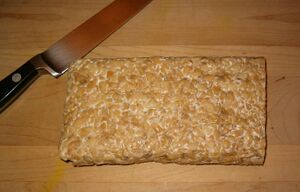Tempeh

Tempeh, or tempe in Javanese, is made by a natural culturing and controlled fermentation process that binds soybeans into a cake form. It is especially popular on the island of Java, where it is a staple source of protein. Like tofu, tempeh is made from soybeans, but tempeh is a whole soybean product with different nutritional characteristics and textural qualities. Tempeh's fermentation process and its retention of the whole bean give it a higher content of protein, dietary fibre and vitamins compared to tofu, as well as firmer texture and stronger flavour. Tofu, by contrast, is said to be more versatile in dishes. Because of its nutritional value, tempeh is used worldwide in vegetarian cuisine; some consider it to be a meat analogue. Even long before people found and realised its rich nutritional value, tempeh was referred to as “Javanese meat.”
Tempeh begins with whole soybeans, which are softened by soaking and dehulled, then partly cooked. Specialty tempehs may be made from other types of beans, wheat, or may include a mixture of beans and whole grains.
A mild acidulent, usually vinegar, may be added in order to lower the pH and create a selective environment that favours the growth of the tempeh mold over competitors. A fermentation starter containing the spores of fungus Rhizopus oligosporus is mixed in. The beans are spread into a thin layer and are allowed to ferment for 24 to 36 hours at a temperature around 30°C (86°F). In good tempeh, the beans are knitted together by a mat of white mycelia.
Under conditions of lower temperature, or higher ventilation, gray or black patches of spores may form on the surface—this is not harmful, and should not affect the flavour or quality of the tempeh. This sporulation is normal on fully mature tempeh. A mild ammonia smell may accompany good tempeh as it ferments, but it should not be overpowering. In Indonesia, ripe tempeh (two or more days old) is considered a delicacy.
How To Make Tempeh
- Prepare selected soybeans and wash them with clean water for an hour.
- Boil for two hours.
- Submerge again in hot/warm water for 12 hours to increase the size of the beans.
- Submerge in cold water for another 12 hours.
- After 24 hours of submerging, peel off the outer layer of the beans.
- Boil the soybeans just enough to kill any germs that developed during submersion.
- Put the soybeans in a separate container, and leave them to dry or until there is no water left.
- Mix the soybeans with yeast, the fermentation will take about 20 minutes to develop some fungi on the surface. This is the most important phase of making your own tempeh.
- Roll the fermented soybeans in plastic wrap with small holes in it (to allow the fungi to breathe). Traditionally, the fermented beans were wrapped in banana or teak leaves.
- Leave away from sunlight for 24 hours.
- After 24 hours, leave them into place with light and fresh air for another 24 hours
- The fermented soybeans have become tempeh and are ready for consumption or packaging.
Find recipes that contain 'Tempeh'
#tempeh #soybeans #beans #fungi #tofu #wheat #fermented #ferment #dietaryfibre #soybean #vegetariancuisine